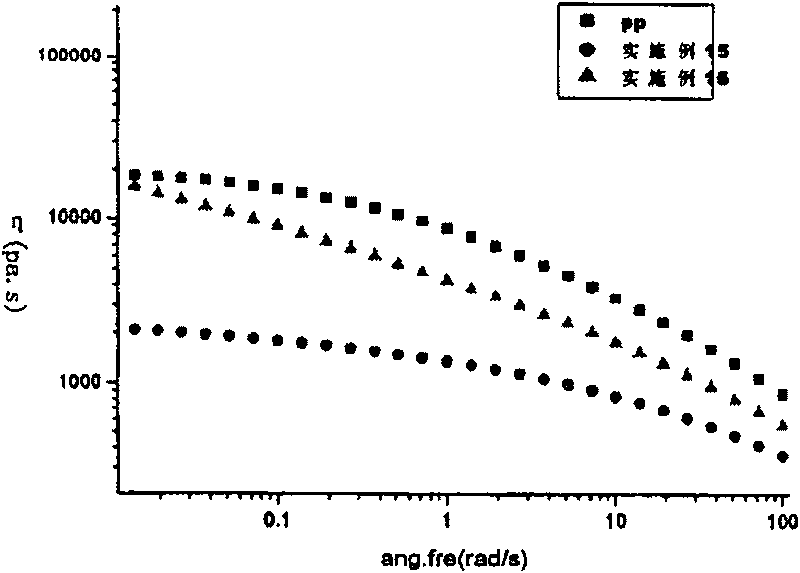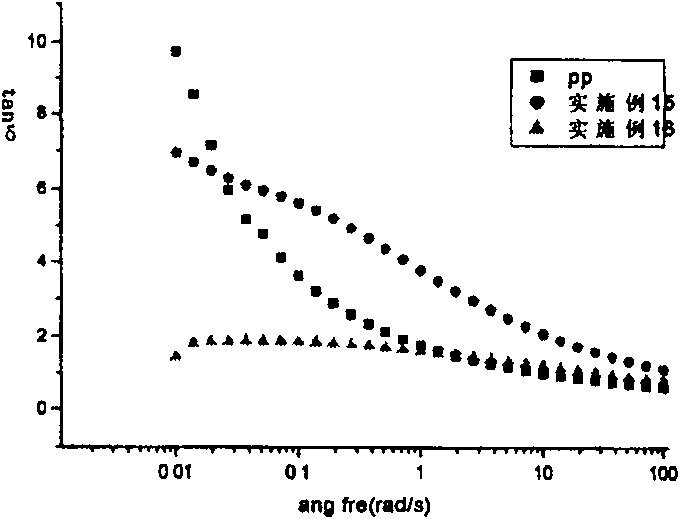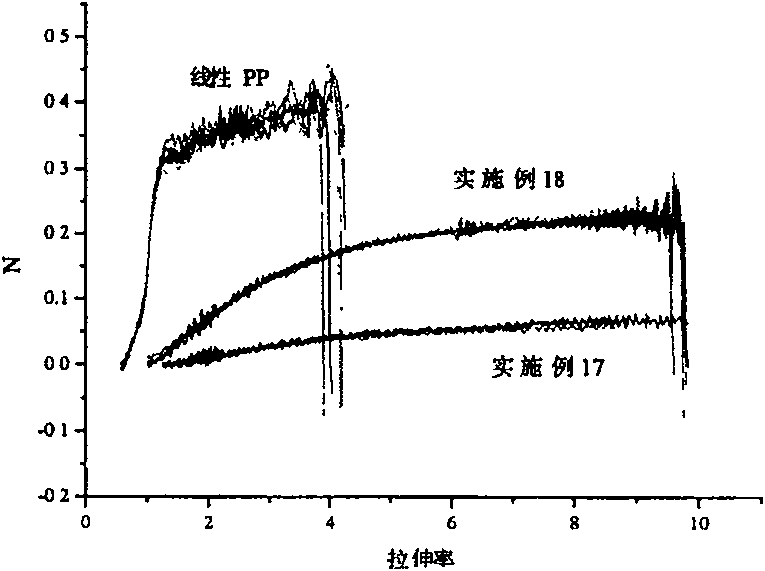Branched polypropylene and its preparation method
A branched polypropylene, polypropylene technology, applied in the field of branched polypropylene and its preparation, can solve the problems of decreased melt strength, poor sag resistance, limited application of polypropylene, etc., and achieves good processing rheological properties , High melt strength, the effect of inhibiting β-fracture reaction
- Summary
- Abstract
- Description
- Claims
- Application Information
AI Technical Summary
Problems solved by technology
Method used
Image
Examples
Embodiment 1
[0033] 50g propylene copolymer of 4-methylstyrene and propylene (MFR=0.883, 4-methylstyrene unit molar content is 1.55*10 -2 %) into the internal mixer at a temperature of 210°C, stirring for 2 minutes, adding 0.77 g of trimethyl alcohol hydroxypropane triacrylate, stirring for 1 minute, and then simultaneously adding 0.0352 g of 2,5-dimethyl-2,5-di-tert- Butylperoxyhexane and 15mg tetraethylthiurab dithioester (TETDS) were reacted for 7 minutes and discharged to obtain branched polypropylene with a branching ratio of 0.3 / 1000°C and a melt strength of 223mN.
Embodiment 2
[0035] 50g of propylene copolymer of 4-methylstyrene and propylene (MFR=0.847, 4-methylstyrene unit molar content is 2.74*10 -2 %) into the internal mixer at a temperature of 210°C, stirring for 2 minutes, adding 0.88 g of trimethyl alcohol hydroxypropane triacrylate, stirring for 1 minute, and then simultaneously adding 0.0352 g of 2,5-dimethyl-2,5-di-tert-butyl Hexyl peroxide reacted with 15mg tetraethylthurium dithioester for 7min and then discharged to obtain branched polypropylene with a branching ratio of 0.43 / 10000C and a melt strength of 235mN.
Embodiment 3
[0037] 50g propylene copolymer of 4-methylstyrene and propylene (MFR=0.297, 4-methylstyrene unit molar content is 3.71*10 -2 %) into the internal mixer at a temperature of 210°C, stirring for 2 minutes, adding 0.99 g of trimethyl alcohol hydroxypropane triacrylate, stirring for 1 minute, and then simultaneously adding 0.0352 g of 2,5-dimethyl-2,5-di-tert-butyl Hexyl peroxide and 15mg of tetraethylthiurabdithioester reacted after 7min to obtain branched polypropylene, and its branching rate was 0.45 / 10000C, and the melt strength of gained branched polypropylene was 237mN.
PUM
| Property | Measurement | Unit |
|---|---|---|
| melt flow index | aaaaa | aaaaa |
| melt flow index | aaaaa | aaaaa |
| melt strength | aaaaa | aaaaa |
Abstract
Description
Claims
Application Information
 Login to View More
Login to View More - R&D
- Intellectual Property
- Life Sciences
- Materials
- Tech Scout
- Unparalleled Data Quality
- Higher Quality Content
- 60% Fewer Hallucinations
Browse by: Latest US Patents, China's latest patents, Technical Efficacy Thesaurus, Application Domain, Technology Topic, Popular Technical Reports.
© 2025 PatSnap. All rights reserved.Legal|Privacy policy|Modern Slavery Act Transparency Statement|Sitemap|About US| Contact US: help@patsnap.com



